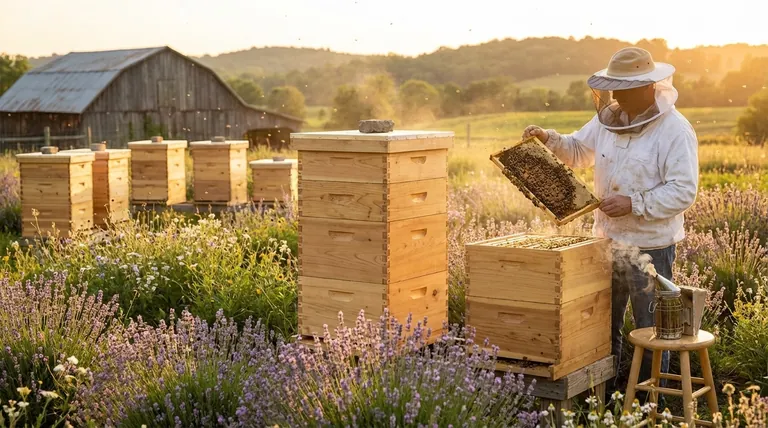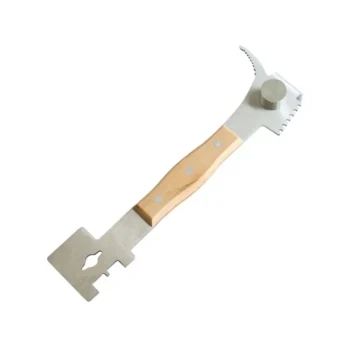In short, the Langstroth hive is the global standard for beekeeping because it is a modular, expandable system with interchangeable parts. This design prioritizes ease of management and maximum honey production, making it highly efficient, widely available, and more affordable than other hive types.
The Langstroth hive's dominance isn't an accident. Its design is a masterclass in efficiency, built around a key insight into bee behavior that allows for easy inspection, seamless expansion, and superior honey yields.

The Foundational Principle: Understanding "Bee Space"
The genius of the Langstroth hive isn't the box itself, but the precise spacing it enforces. This core concept is what unlocks all of its other benefits.
The Discovery of Bee Space
In 1851, Rev. Lorenzo Langstroth observed that bees consistently leave a gap of about 3/8 of an inch (9.5 mm) as a walkway between their combs.
If a space is smaller, bees will seal it with propolis (a sticky resin). If it's larger, they will build excess "burr comb" to fill it. Langstroth designed his hive to maintain this "bee space" around every frame.
The Power of Removable Frames
By respecting bee space, Langstroth created the first hive with truly removable frames. Because the frames don't get glued to the hive body or to each other, a beekeeper can slide them out one by one.
This allows for easy inspection of the colony's health, queen status, and food stores without destroying the comb, representing a revolutionary leap in hive management.
Practical Advantages for the Beekeeper
The Langstroth's foundational design translates directly into several powerful, practical benefits that have made it the industry standard.
Unmatched Expandability
The hive consists of simple, stackable boxes (often called "supers" or "hive bodies"). As a colony grows and needs more space for brood or honey, you simply add another box on top.
This vertical, modular system allows the hive to expand or contract precisely with the needs of the colony and the nectar flow, preventing swarming and maximizing storage.
Interchangeable and Standardized Parts
Langstroth hives are built to standardized dimensions. A deep hive body or medium super from one manufacturer will almost always fit perfectly with components from another.
This interchangeability makes replacing parts, expanding your apiary, or buying used equipment simple and cost-effective. You are not locked into a single supplier.
Maximized Honey Production
The design is engineered for honey. The large, rectangular frames encourage bees to draw out comb and store honey efficiently. Vertical expansion gives them nearly unlimited room to store nectar during a strong flow.
This is why the Langstroth consistently produces the highest honey yield compared to other popular designs like the Top Bar or Warre hive.
Widespread Availability and Affordability
Because it is the global standard, the Langstroth hive benefits from economies of scale. Components are mass-produced by numerous suppliers, making it the most affordable and widely available hive on the market.
A Vast Community of Knowledge
Its popularity means that nearly every beekeeping book, course, and online forum is centered on Langstroth management. For a beginner, this vast repository of shared knowledge and community support is an invaluable resource.
Understanding the Trade-offs
While dominant, the Langstroth hive is not perfect for every beekeeper. Objectivity requires acknowledging its disadvantages.
The Weight Factor
A deep hive body full of brood, pollen, and honey can weigh 80-100 lbs (36-45 kg). A medium super full of honey can weigh 40-50 lbs (18-23 kg). Lifting these boxes is the most physically demanding part of beekeeping.
A Focus on Production
The design prioritizes honey production and ease of inspection, which can feel more intrusive than methods used with other hives. Beekeepers focused on a more "natural" or "bee-centric" approach may prefer a less interventionist design like a Top Bar hive.
Is the Langstroth Hive Right for You?
Choosing a hive means matching the design to your personal beekeeping goals.
- If your primary focus is maximizing honey production: The Langstroth is the undisputed champion and the logical choice.
- If you are a beginner seeking the most support: The vast educational resources and community built around the Langstroth make it the easiest hive to learn.
- If you have physical limitations or want to avoid heavy lifting: Consider using all medium-sized Langstroth boxes or look into alternative designs like the Top Bar hive.
- If your goal is backyard pollination with minimal intervention: A more "natural" hive design might align better with your philosophy, but a Langstroth can also be managed with less intensity.
Ultimately, the Langstroth hive's design provides a flexible and efficient framework that has empowered beekeepers for over 150 years.
Summary Table:
| Key Benefit | Description |
|---|---|
| Modular & Expandable | Stackable boxes allow the hive to grow with the colony, preventing swarming and maximizing honey storage. |
| Removable Frames | Easy inspection of colony health and food stores without damaging the comb, thanks to the 'bee space' principle. |
| Standardized Parts | Interchangeable components from different suppliers make repairs and expansion simple and cost-effective. |
| Maximized Honey Yield | The design is engineered for high-efficiency honey production, consistently outperforming other hive types. |
| Widespread Support | As the global standard, it has the largest community of knowledge and most affordable, widely available equipment. |
Ready to equip your commercial apiary or distribution business with the industry's best equipment?
HONESTBEE supplies high-quality, durable Langstroth hive components and other essential beekeeping supplies through our wholesale-focused operations. Our standardized equipment ensures compatibility and reliability, helping you maximize productivity and honey yields.
Contact our wholesale team today to discuss your needs and get a quote.
Visual Guide

Related Products
- Long Langstroth Style Horizontal Top Bar Hive for Wholesale
- Ergonomic Two Person Foldable Hive Lifter
- Wholesales Dadant Size Wooden Bee Hives for Beekeeping
- Multi-Function Hive Tool with Integrated Hammer for Beekeeping
- Professional Grade Foldable Beehive Handles
People Also Ask
- What are the most popular types of hives besides the Langstroth? Top Bar & Horizontal Hives Explained
- What are the advantages of a top bar hive? Simpler, Bee-Centric Beekeeping for All
- What is a top bar bee hive? A Natural, Low-Stress Beekeeping Solution
- What are the benefits of a top bar hive? A Natural, Low-Impact Approach to Beekeeping
- What are the box management requirements for a top bar hive vs. Langstroth? Choose Your Hive Strategy



















